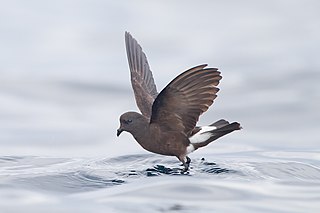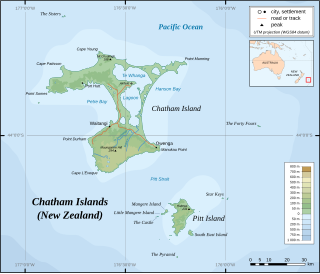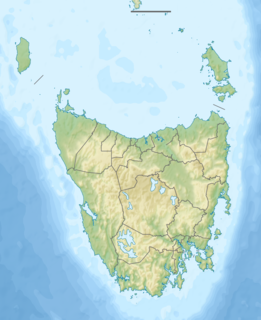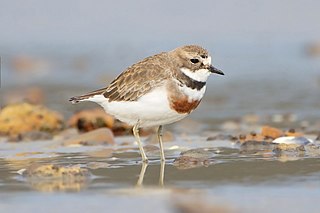
Northern storm petrels are seabirds in the family Hydrobatidae, part of the order Procellariiformes. The family was once lumped with the similar austral storm petrels in the combined storm petrels, but have been split as they were not closely related. These smallest of seabirds feed on planktonic crustaceans and small fish picked from the surface, typically while hovering. Their flight is fluttering and sometimes bat-like.

The diving petrels are seabirds in the bird order Procellariiformes. There are five very similar species all in the family Procellariidae and genus Pelecanoides, distinguished only by small differences in the coloration of their plumage, habitat, and bill construction. They are only found in the Southern Hemisphere. Some authorities place the diving petrels in their own family, the Pelecanoididae.[2]

Wilson's storm petrel, also known as Wilson's petrel, is a small seabird of the austral storm petrel family Oceanitidae. It is one of the most abundant bird species in the world and has a circumpolar distribution mainly in the seas of the southern hemisphere but extending northwards during the summer of the northern hemisphere. The world population has been estimated to be more than 50 million pairs. The name commemorates the Scottish-American ornithologist Alexander Wilson. The genus name Oceanites refers to the mythical Oceanids, the three thousand daughters of Tethys. The species name is from Latin oceanus, "ocean".

The white-faced storm petrel, also known as white-faced petrel is a small seabird of the austral storm petrel family Oceanitidae. It is the only member of the monotypic genus Pelagodroma.

The southern giant petrel, also known as the Antarctic giant petrel, giant fulmar, stinker, and stinkpot, is a large seabird of the southern oceans. Its distribution overlaps broadly with the similar northern giant petrel, though it overall is centered slightly further south. Adults of the two species can be distinguished by the colour of their bill-tip: greenish in the southern and reddish in the northern.

Robert Cushman Murphy was an American ornithologist and Lamont Curator of birds at the American Museum of Natural History. He went on numerous oceanic expeditions and was an expert on marine birds, and wrote several major books on them. He described a species of petrel which is now known as Murphy's petrel. Mount Murphy in Antarctica and Murphy Wall in South Georgia are named after him.

The Sisters, or Rangitatahi in Maori, is a group of three islands located 16 kilometres (10 mi) north of Cape Pattison, Chatham Island. They are the northernmost members of the Chatham Archipelago, located 800 kilometres (497 mi) east of New Zealand's South Island.

The common diving petrel , also known as the smaller diving-petrel or simply the diving-petrel, is a diving petrel, one of five very similar auk-like small petrels of the southern oceans. It is native to South Africa and islands of the southern Indian Ocean, islands and islets off New Zealand and south-eastern Australian islands.

The South Georgia diving petrel or Georgian diving-petrel is one of five very similar small auk-like diving petrels of the southern oceans. It is native to the South Atlantic and islands of the southern Indian Ocean and south-eastern Australia.

The Little Chalky Island, part of the Big Green Group within the Furneaux Group, is a 5-hectare (12-acre) unpopulated granite island, located in the Bass Strait, west of the Flinders Island and south of Chalky Island, in Tasmania, in south-eastern Australia. The island is part of the Chalky, Big Green and Badger Island Groups Important Bird Area.

The Chalky Island, part of the Big Green Group within the Furneaux Group, is a 41-hectare (100-acre) unpopulated granite island with limestone outcrops and dolerite dykes, located in the Bass Strait, west of the Flinders Island, in Tasmania, in south-eastern Australia. The island is contained within a conservation area and is part of the Chalky, Big Green and Badger Island Groups Important Bird Area.

The Stony Brook Seawolves football program is the collegiate football team that represents Stony Brook University at the NCAA Division I level. The program participates in the Division I Football Championship Subdivision and currently competes in the eleven-member Colonial Athletic Association. The program plays its home games at Kenneth P. LaValle Stadium in Stony Brook, New York.

Carrel Island, also known as Le Mauguen Island, is a small, rocky island 400 m long lying 200 m south of Petrel Island in the Géologie Archipelago of Antarctica. It was charted in 1950 by the French Antarctic Expedition and named by them for Alexis Carrel, noted French surgeon and physiologist.
The 2010 Stony Brook Seawolves football team represented Stony Brook University in the 2010 NCAA Division I FCS football season as an associate member of the Big South Conference. The team was coached by Chuck Priore and played their home games in Kenneth P. LaValle Stadium at Stony Brook, NY. The Seawolves ended their regular season 6–5, 5–1 in Big South play to earn it second straight Big South conference title shared with Liberty and Coastal Carolina. Due to a three-way tie in the conference title the automatic bid to the FCS playoff was given to Coastal Carolina, not Stony Brook who allowed more points against the Big South opponents.

Cabbage Tree Island, also known as the John Gould Nature Reserve, is a protected nature reserve and uninhabited continental island lying 1.4 km (0.87 mi) off the mouth of Port Stephens on the coast of New South Wales, Australia. The 30 ha (74-acre) reserve and island is named for the Cabbage-tree Palms in the two gullies on the island's western side which are the nesting site of Goulds petrel. It is the principal breeding site of the nominate subspecies of the threatened Gould's petrel and, with the nearby Boondelbah Island where there is also a small colony, has been classified by BirdLife International as an Important Bird Area. Both Cabbage Tree and Boondelbah Islands are gazetted nature reserves under the New South Wales National Parks and Wildlife Act, so protecting the island's habitat from land uses incompatible with nature conservation. Access is only permitted for scientific and conservation purposes.
Chuck Priore is the current head coach of the Stony Brook Seawolves football team, which represents Stony Brook University in the NCAA, and participates in the Colonial Athletic Association. Priore was hired prior to the 2006 season and he led the transition of Stony Brook into a full-scholarship FCS program from the 2006 season in which the team awarded an equivalent 27 scholarships. In 2007, the team played as an independent while adding scholarships and a tougher schedule. In 2008, Stony Brook joined the Big South Conference as a full–scholarship program. Priore led the Seawolves to three consecutive Big South championships and so far has compiled a 37–31 record. Under the leadership of Priore the Seawolves played their first ever FBS opponent, South Florida, in the 2010 season. In 2011, Stony Brook won their first outright Big South Championship and participated for the first time in the FCS playoffs, advancing to the Second Round.

The Robbins Passage and Boullanger Bay Important Bird Area is a 238 km2 tract of land at the western end of the north coast of Tasmania, south-eastern Australia. It comprises extensive areas of intertidal mudflats and saltmarsh with adjacent farmland. It is an important site for waders, or shorebirds.















